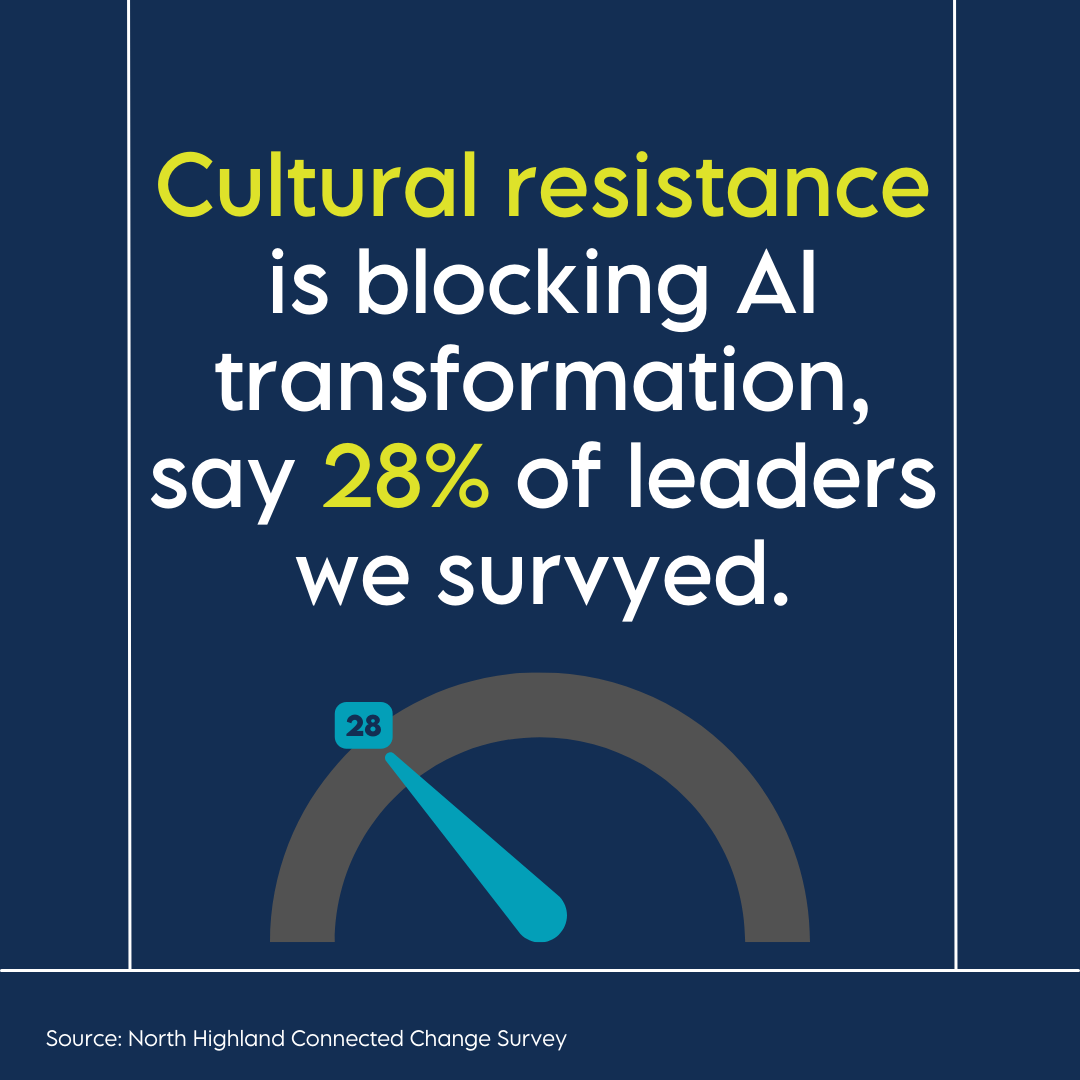.png)
In part one, we explored the risks of moving too fast—or too slow—along an artificial intelligence (AI) transformation journey. Now, in part two, we provide North Highland’s methodology for setting a pace that balances speed with impact for higher value deployments.
It’s not that organizations have necessarily gone the wrong way with AI. It’s more that they haven’t had a direction at all.
The way the business world has initially approached AI is a testament to the power of hype.
It’s like we all collectively started a cross-county road trip with no map, no snacks, and no goals, other than to submit to the allure of California’s sparkling coastline. Lacking a route we meandered, burning fuel, until we ultimately landed in…Colorado. And Colorado is beautiful. But Colorado was not the destination we set out for; it won’t bring us the impact we seek.
The path to successful AI adoption and transformation lies in resisting the hype of AI hyperbole and the comfort of business-as-usual. It requires us to address the blind spots in strategic prioritization, and to recognize the speed bumps and pitfalls of fragmented AI initiatives. It calls for a connected, masterfully routed, knowledge-driven approach.
Start navigating with impact now: Three markers along a journey toward AI-enabled value at pace.
North Highland’s approach to AI deployment is different: We build long-term AI capabilities, not hype-driven AI dependencies.
More than any other technology of our time, AI requires transformation. It demands connected change. So, our approach takes clients beyond tech implementation to connect the physical world to their operational systems in ways that are flexible, safe, integrated, and scalable.
Here’s how North Highland helps organizations set the right pace for AI transformation:
Zoom out.
Set your AI destination.
Rooting your AI transformation in the right reasons is harder than it seems. Why? Because for most people, AI is still a mostly unknown quantity.
If you were to ask people on the street, “How can AI improve your quality of life”, you might get musings about dish-doing robots or flying cars. While possible, these ideas woefully underestimate the real potential of AI.
Leaders must set realistic ambitions, guided by best-practices and external expertise. The value of these ambitions might simply be to learn more, and to establish the systems, processes, and cultural buy-in needed continuously improve.
Build AI awareness within executive leadership.
Is your CEO using AI? If executive leadership doesn’t personally buy into its value, it will be doubly challenging to successfully implement AI in your organization.
To build awareness, you must know where you’re starting from. North Highland conducts AI Maturity Assessments to help our clients understand and build readiness across their full organizational structures.

Define your AI value framework and establish a common language.
The barrier to AI value isn’t the tech. It’s the culture.
AI adoption requires full cultural buy-in. The exclusivity of language, process, and tools that may have worked for other initiatives won’t be effective with AI. There must be a common understanding and language that’s shared across the entire organization.
Having a clear value framework helps determine which case studies to focus on, based on how much impact they could have and how well they support strategic objectives.
Discover AI-enabled use case opportunities.
Finding use cases should be easy: When North Highland began deploying AI internally, we identified 28 use cases targeting productivity and efficiency gains alone. What is difficult is determining which one to move forward with.
In our case, we zoomed out to aggregate those 28 uses cases into three macro and flexible use cases that accelerated our time to market and delivered 5x ROI, versus implementing 28 fragmented solutions.
Connect the dots.
Identify the experts with a focus on building competency, not dependency.
Far too many experts are taking organizations down a path of fragmentation. They’re helping organizations start little AI wildfires everywhere, with no connection to AI value drivers (collective knowledge, governance, technology, roles, and processes). These experts are building dependencies, not AI competencies, and it’s important for leaders to understand the difference.
"A true transformation partner doesn't just implement technology; they connect the dots between strategy, execution, and impact. By aligning AI initiatives with business goals and fostering a culture of continuous learning, organizations ensure sustainable success and real value creation." - Scott Tedcastle
As a transformation partner, North Highland emphasizes building lasting AI capabilities to help businesses sustain and compound improvements over time. By thoroughly assessing existing internal capabilities and providing coaching on the importance of each capability to overall success, North Highland ensures that the work continues even when their experts are gone. This immersive approach to capability development, coupled with the integration of co-sourced talent with existing teams, creates an environment for sustainable AI success.
Prioritize and align on knowledge documentation and development.
This isn’t your data management of yore. AI requires more than robust data collection and processing. It requires capturing the implicit knowledge of how things get done in an organization; the context of the work. And it requires upskilling talent and fostering a culture of continuous sharing and learning.
Zoom in.
Route your AI journey.
Only once you’ve zoomed out and connected the dots can you develop a strategic roadmap that balances speed with impact.
North Highland roadmaps activate knowledge repositories and business stakeholders against strategically sequenced AI initiatives that balance large-scale transformation projects with quick-win opportunities.
Develop and implement AI governance and risk mitigation.
More than just the seatbelts, these frameworks are the required guardrails, brakes, and hazard lights of a lower risk, higher value AI road trip.
Keep in mind, governance is not a set-it-and-forget-it process: These frameworks must be continuously improved and adapted throughout an AI lifecycle.
Execution: Where leadership & change management converge
This is where theory meets practice and where your carefully calibrated pace can prove its worth. We can tell you it’s about deploying change management strategies (and it is), but these practices won't take root unless leaders model the change they seek.
This means moving beyond proclamations of “AI everywhere” to demonstrating how they’re personally adapting their roles and decision-making processes. When employees see their leaders actively engaging with AI—not just mandating its use—transformation will gain momentum.
Cultural resistance gives way to innovation when you:
- Transform employees from AI targets to evangelists through hands-on experience and education
- Co-create solutions that tap into institutional knowledge and expertise
- Guide teams in reimagining their roles alongside AI, not in competition with it
- Create clear pathways for developing AI-adjacent skills that enhance existing capabilities
Role evolution becomes the cornerstone of sustainable transformation. For employees with deep industry tenure, this means discovering how their expertise becomes more valuable—not less—in an AI-enabled environment. For teams, it means seeing AI as an efficiency ally that amplifies their impact rather than diminishes their importance.
As you scale from proof of concept to enterprise-wide deployment, reinforce this people-centric approach through:
- Democratized accountability for AI ethics
- Rigorous privacy standards for employee data
- Continuous improvement powered by human-in-the-loop reinforcement learning
Remember: The organizations that successfully transform with AI don't just change their technology—they evolve their entire approach to change itself. North Highland's Managed Services approach helps you navigate this evolution, building lasting AI capabilities that create value long after implementation. Our focus on developing competency—not dependency—ensures your organization can sustain and accelerate transformation at the right pace. And unlike our earlier road trip analogy, you’ll arrive exactly where you intended to go; no unexpected Midwest detours required.
CONNECTED CONTENT


.jpg9157.webp?itok=dVlauYF4)

2a6b.jpg?itok=4MSoMV8M)
